Now in its sixth year, Asia Week New York continues its tradition of unveiling a spectacular trove of superlative Asian works of art – all making their debut at exhibitions which open simultaneously at galleries throughout Manhattan, commencing Friday, March 14 and running through Saturday, March 22, 2014.
Asia Week New York brings together a top-tier roster of 47 international Asian art specialists—the largest number to date—from Australia, Belgium, England, France, Germany, Italy, Switzerland, Japan, Korea, and the United States. Joining them are five major auction houses as well as 19 world-renowned museums and Asian cultural institutions. All work together towards a shared goal to weave Asian art into the cultural fabric of New York and to broadcast its unique appeal worldwide.
Says Carol Conover, Chairman of Asia Week New York 2014: “This year represents a landmark occasion for Asia Week New York. Never in its history has it experienced such a high level of participation from galleries in the United States and abroad. We are thrilled to welcome the outpouring of collectors, curators and lovers of Asian art to our city – all in celebration of this shared passion.”
Asia Week New York exhibitions are open and free to the public, and each reveals the rarest and finest Asian examples of ceramics, jewelry, textiles, paintings, sculpture, bronzes, prints, photographs and jades, representing artistry, ingenuity and imagination from every corner and time period of Asia.
Organized by category, here is a roundup of exhibitions at the participating galleries:
CHINESE ANCIENT THROUGH CONTEMPORARY ART
 |
From Los Angeles, Asian Art Studio will show an enchanting enamel-on-glass snuff bottle by Ye Bengqi, circa 1938, as part of the exhibition Noble Treasures on the Seventh Floor of the Fuller Building, 41 East 57th Street. The bottle boasts provenance from the Chepsted Collection and, before that, from the Mack Collection. It has been published in books about both of those collections, most recently in 2013's “The Chepsted Notebook: A Collection of Chinese Snuff Bottles.” |
 |
In their exhibition Chu Kingdom at Trinity House, 24 East 64th Street, Galerie Jacques Barrère of Paris will highlight a carved wooden Phoenix on Tiger, with deer antlers. The Phoenix, one of the four mythical animals of Chinese mythology, was a central creature in the funeral ceremonies of the Chu Kingdom. Associated with good fortune and bringing peace on earth, the phoenix also has the capacity to fly, the ultimate privilege adopted by the Immortals in the afterlife. This sculpture is a remarkable example of the importance of this cult in the Chu culture. |
 |
The Ralph M. Chait Galleries, Inc. is presenting Spring Exhibition of Chinese Porcelain and Works of Art in their new gallery now located on the Twelfth Floor of the Crown Building, 730 Fifth Avenue. Among their impressive offerings is a rare and superb Chinese large stucco figure of a Lohan, posed and seated wearing a long harlequin gown, circa 13/14th century. |
 |
To See a World in a Grain of Sand is the intriguing title of the show at China 2000 Fine Art at 177 East 87th Street, Suite 601. One of the focal points is a work by Annysa Ng. Born in Hong Kong and named one of the “Ten Talents to Watch” by The Times of London, Ng’s featured work, Embrace Nothingness II, a dreamy, complex ink and acrylic on canvas with silver gilding created in 2013, shows Ariadne's thread with one end tied to her wrist and the other to the labyrinth-like mindscape of the Minotaur. |
 |
The Chinese Porcelain Company presents three simultaneous exhibitions Landscape and Nature in Chinese Contemporary Ink Painting, A Collector’s Choice: Early Chinese Ceramics and Ming and Qing Bronzes at its location at 475 Park Avenue. Featured are prominent ink painters Liu Dan, Zeng Xiaojun, Tai Xiangzhou, Shen Quin, Lee Chunyi and Zhang Yirong as well as early green-glazed ceramics and later figurative bronzes. |
 |
At the Gagosian Gallery, 980 Madison Avenue, Gisèle Croës of Brussels will be exhibiting a number of superb archaic bronze vessels in Matter and Memory. Among them is an archaic bronze vessel from the late Shang dynasty (1600-1050 B.C.) adorned with cuprite, malachite and azurite crystallization. From the 17th century B.C. to the 2nd century A.D., these bronze vessels represented the first decisive step in the development of Chinese art, playing an essential role in ceremonies connecting the living and the dead and revealing an awe-inspiring expertise in the art of casting. |
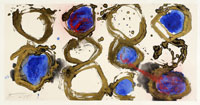 |
London’s Michael Goedhuis will be showing Wei Ligang: Chinese Palaces, an important retrospective exhibition of the Chinese contemporary ink painter’s work at Mallett, 929 Madison Avenue. A highlight from this show is the beautiful Peacock: Pearl, a work in ink, acrylic and lacquer on paper from 2012. The artist will be present at the opening. |
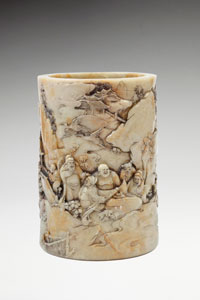 |
Revealing rare treasures at Hazlitt Gooden & Fox, 17 East 76th Street, is Brooklyn’s Nicholas Grindley Works of Art Ltd. in a display called Chinese Furniture and Scholars’ Objects. One in particular is a soapstone brush pot by a carver, Lin Qingqing, known more for his seal carving. The piece probably dates from the late Republic era, and it vividly demonstrates that high quality craftsmanship did not die out at the end of the 18th century, as is commonly interpreted. |
| At the Mark Murray Gallery on the Fifth Floor of 39 East 72nd Street, Michael C. Hughes, LLC of New York will be offering tantalizing creations from the Tang Dynasty (618-907) in Recent Acquisitions—Chinese Works of Art. Among them are a blue-glazed lady holding a goose, an amber camel and a pair of three-color glazed earth spirits. Also spotlighted is a selection of exceptional textiles, including a mid-late Ming embroidery of Guan. | |
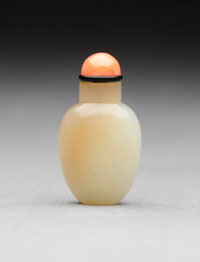 |
Presented by Jadestone of Portland, Oregon, Diminutive and Dynamic: Miniature Chinese Snuff Bottles and Works of Art on the Ninth Floor of the Fuller Building, 41 East 57th Street, features an unforgettable nephrite snuff bottle attributed to the palace workshops in Beijing and dating between 1740-1820. The bottle has been published and exhibited several times and was part of the Mary and George Bloch collection of Chinese snuff bottles, considered to be one of the finest collections of Chinese snuff bottles. |
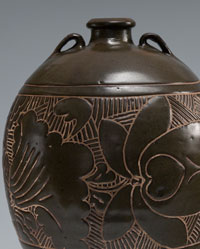 |
Andrew Kahane, Ltd. of Forest Hills, N.Y., will feature an early 13th century Cizhou cut-glaze vase, Jin Dynasty (1115-1234), at his exhibition entitled Chinese Ceramics and Works of Art at The Mark Hotel, 25 East 77th Street. A bold flower design set on a distinctive hatch pattern ground is associated with Cizhou ware ceramics from Datong, Shanxi province. |
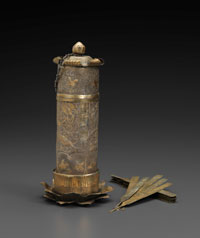 |
Special emphasis is placed on a gilt-silver wine-drinking game set included in the exhibition, The Immortal Past, at Kaikodo LLC at 74 East 79th Street, Suite 14B. This splendidly decorated set is one of only two known to exist, and made during the Tang Dynasty in the 8th century. The 30th volume of the Kaikodo Journal will accompany the exhibition. |
 |
From J.J. Lally & Co., 41 East 57th Street, an ancient Chinese bronze bell (nao) is particularly noteworthy in their exhibition, Archaic Bronzes: The Collection of Daniel Shapiro. This very rare and boldly cast clapper-less bell dates from the 11th or 10th century B.C., the time of the late Shang/Early Western Zhou Dynasty. Scholars speculate that bells of this sort, standing almost a foot and a half tall and rung with a mallet, were used in nature worship, or perhaps to sound an alarm in an emergency or to signal troops in a military campaign. A second exhibition, titled Ancient Chinese Sculpture: Recent Acquisitions will also be on view. |
 |
In the Rare Book Room of the Arader Galleries, 29 East 72nd Street, Santos-London is displaying 100 Years of Export Porcelain, 1650-1750. One of the stars is a large Chinese porcelain tea-dust-glazed vase with a base bearing the six-character mark of Guangxu (1875-1908). |
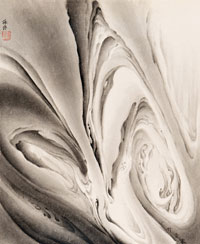 |
Chinese Contemporary Painting: New Works by Hai Tao is the name of the show that M. Sutherland Fine Arts Ltd. is hanging on the gallery walls on the Second Floor of 55 East 80th Street. Of special note is Hai Tao's Maelstrom, an ink-on-rice-paper work from 2010. It measures 12¾ by 10¼ inches. |
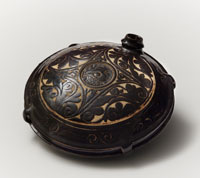 |
In Early Chinese Ceramics: Monochromes, Zetterquist Galleries, 3 East 66th Street, unveils a carved Cizhou-type canteen, an important piece that has been published in two books and exhibited in the groundbreaking exhibition, Hare's Fur, Tortoiseshell and Partridge Feathers at Harvard and in New York. Dating from the Xixia Kingdom or Jin Dynasties, 12th-13th century A.D., this striking stoneware canteen is in the shape of a tortoise. |
INDIAN, HIMALAYAN, AND SOUTHEAST ASIAN WORKS OF ART
 |
Walter Arader Himalayan Art at 1016 Madison Avenue has singled out a fine Qianlong period painting of Rolpai Dorje (1717-1786) for his exhibition, Fine Himalayan Art. By far the most notable aesthetic aspect of this unforgettable portrait is that, whereas the subsidiary figures, background, and body of Rolpai Dorje are all executed in the Yonghe style, the portrait face of Rolpai Dorje is executed in an Italian Baroque style. |
 |
San Francisco’s Art Passages presents Paintings from the Courts of India and Persia at the Isselbacher Gallery, 41 East 78th Street, and among the artworks is a fine example of the Persian Shirazi school of painting. Dating from the 16th century and measuring 8 by 7 inches, this illuminated leaf from Qazvini's 'Aja'ib al-Makhluqat or wonders of creation, depicts men performing their ablutions in a bathhouse. |
 |
Prahlad Bubbar of London will debut Indian Court Paintings: Recent Acquisitions with a Preview of Gianni Berengo Garden in India at 1016 Madison Avenue. One of the most prominent works is a portrait of Maharana Bhim Singh of Udaipur, attributed to the master artist Chokha, known for his bold forms and witty characterization. Unusually large in size and finely finished with elaborate detailing and impasto pearls, it is an important contribution to the body of Mewari court portraiture. |
 |
Exhibiting From Angkor Wat to the Himalayas at Arader Galleries, 29 East 72nd Street, is Buddhist Art, coming to Asia Week New York from Berlin and bringing a Buddhist triad comprising Buddha Mucalinda, Avalokitesvara and Prajnaparamita. This masterwork originates from Angkor Wat during the 12th century, when there was growing interest in Mahayana Buddhism in the Khmer empire. The Buddhist triad, representing the Buddha seated on the coils of a snake flanked by Lokeshvara, the God of Compassion, and Prajnaparamita, the Goddess of Wisdom became one of the most important sacred images the Buddhist triad. |
 |
Brussels-based Carlo Cristi, is presenting a selection of Latest Acquisitions and Central Asian Textiles at 1016 Madison Avenue. Among this rich cache is a soulful 13th-century Tibetan painting showing an unidentified Bonpo master, seated on the folds of his cloak and seeming to rise off the ground—a particularly rare, excellent painting. |
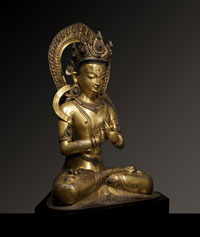 |
Dalton Somaré Gallery of Milan is curating Early Buddhist Art at the Friedman & Vallois Gallery on the Second Floor of No. 27 East 67th Street. A standout among the selection of stone, bronze and clay sculptures is an important 15th-century Newar gilt-copper embossed image of a Tathagata. Decorated with semiprecious stones, it is a testament to the astonishing artistry of Nepali sculptors. |
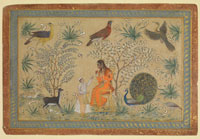 |
Oliver Forge & Brendan Lynch Ltd. of London are mounting a show entitled Indian Painting 1590-1840 in Suite 1A at 9 East 82 Street. One of the highlights of this wonderful undertaking is a painting in the style of Rahim Deccani, an artist of the late 17th and early 18th century. The diminutive work—only 5½ x 8 5/8 inches—presents a regally attired lady who is sipping from a small cup while a prince pours wine from a gilt flask in a fragrant spring garden setting. They are flanked by a doe and a buck and a peacock and peahen, and above are three large naturalistic birds. |
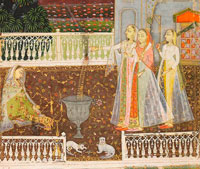 |
In a show bearing the title Indian Paintings & Courtly Objects: Recent Acquisitions, London gallerist Francesca Galloway is giving The Night of Shab-barat – Ladies with Fireworks on a Terrace pride of place. This delightful late-18th-century work, an opaque watercolor heightened with gold on paper, is by the Indian artist Mola Bagas (or Muhammad Bakhsh). The exhibition is taking place at Leslie Feely Fine Art on the fifth floor of 33 East 68th Street. |
 |
At 1016 Madison Avenue, Christophe Hioco of Paris reveals a remarkable bluish-gray limestone head of Buddha in his exhibition, Arts of India, Nepal and Vietnam. The sculpture is a monumental example of the finest art of the Mon-Dvaravati period, circa 7th-8th century C.E. So rare is the work that the last time a similar one was seen on the market was more than a quarter century ago, in 1988. |
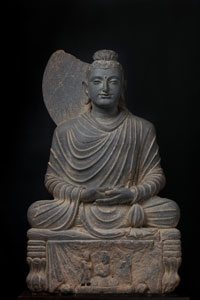 |
Recent Acquisitions introduced by New York gallerist Nayef Homsi, at 1016 Madison Avenue, includes a very elegant and masterfully carved seated Gandharan Buddha in a meditation pose from around the 4th century and made of gray schist. This impressive 30-inch piece was undoubtedly an important commission and then held a prominent place in a stupa complex. |
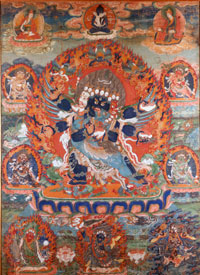 |
A masterfully rendered Tibetan Buddhist painting from the late 17th century plays a prominent role in Wrathful Compassion at Kapoor Galleries, 1015 Madison Avenue. The work, rendered in mineral pigments and gold on cloth, portrays the deity Vajrakila as one the great protectors of Tantric Buddhism, a very rare subject in Tibetan Buddhist paintings. |
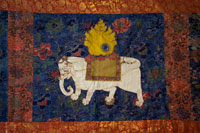 |
At Buddhas from the Himalayas, the exhibition that Moke Mokotoff of New York City and Hudson, N.Y., is mounting on the ground floor of 5 East 82nd Street, a 19-foot long 17th-century Tibetan temple banner will inspire awe in all who gaze upon it. The work depicts Seven Elements of a Universal Good Ruler and is being sold for the benefit of a Tibetan Buddhist monastery. |
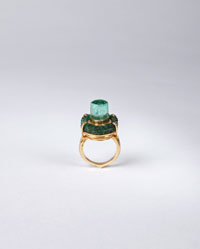 |
Susan Ollemans Oriental Art showcases a 19th-century emerald Lingam ring from South India, measuring 1.2 inches. It can be seen as part of Modern Design in the Ancient World, the London-based gallerist's show at Valentina Gallery Inc., on the second floor of 960 Madison Avenue. This eye-catching piece of jewelry was once worn by a member of the Lingayam sect. |
 |
On the second floor of 121 East 71st Street, in an exhibition entitled Indian, Himalayan and Southeast Asian Art, Carlton Rochell Asian Art spotlights a large-scale, powerfully cast copper-with-gilding Manjusri-Yamantaka, an early example of Himalayan art (circa 1000) that was part of Himalayas: An Aesthetic Adventure, shown at the Art Institute of Chicago, in 2003. |
 |
An early-7th-century seated image of the Buddha is a prime attention-grabber at Early Indian Art from North of Vindhyas and Cholas Sculpture from the South, the outstanding exhibition that John Siudmak Asian Art of London is putting on at the C.G. Boerner Gallery, 23 East 73rd Street. This key Kashmiri bronze sculpture of the Buddha, shown protected by the serpent Mucalinda, has for decades appeared in many scholarly publications, but it has only just come back to light after being tucked away in a private European collection for the past 20 or so years. |
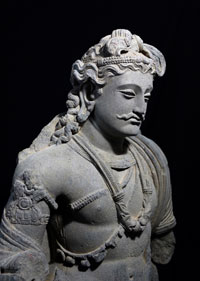 |
At the Arader Galleries, 29 East 72nd Street, Jonathan Tucker Antonia Tozer from London are adding a sterling example of the art of Gandhara to An Important Group of Sculptures from India and Southeast Asia. A 2nd–3rd-century gray schist figure of a Bodhisattva evidences the influences of the Greek world through the treatment of the hair, rainment and jewelry, and is all the more remarkable for its scale, almost 2½ feet tall. |
 |
At the Upper West Side’s landmark Ansonia in Suite 10-18, Nancy Wiener Gallery will present Recent Acquisitions, including a large 19th-century silver ceremonial necklace laden with cabochon rubies. This sumptuous, must-be-seen piece of jewelry is from South India and measures 44½ inches. |
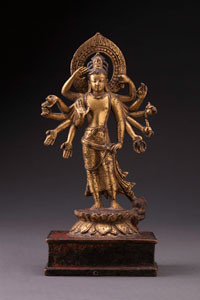 |
San Francisco’s Xanadu Gallery LLC has installed Buddhist & Hindu Sculpture, Japanese Netsuke & Chinese Works of Art on the ground floor of 5 East 82nd Street. Among these rarefied objets d’art is a very fine example of gilt copper alloy, Amoghapasa from Nepal, dating from the 11th-12th century. |
JAPANESE ANCIENT THROUGH CONTEMPORARY ART
 |
BachmannEckenstein Japanese Art of Switzerland is concentrating on Japanese Art—Pre-Modern and Beyond at Gallery Schlesinger/Franklin Riehlman Fine Art on the second floor of 24 East 73rd Street. A hanging scroll landscape in ink and color on silk is worthy of special attention. Created in 1866 by master artist Tomioka Tessai (1836-1924), it is one of many works in the exhibition following the stylistic ideals of Literati painters from the 18th through the early 20th century. |
 |
A cobalt-glazed porcelain piece entitled On the Way and made in 2004 takes honors at Jewels for Homes, the enticing title of the show Dai Ichi Arts, Ltd. is mounting at Hollis Taggart Galleries, 958 Madison Avenue. The 20-inch-tall work is by Miyanada Tozan, a 79-year-old ceramic virtuoso who comes from a long line of traditional potters in Kyoto, where he continues to live and work. |
 |
A limited number of clay sculptures of a kneeling lady were made around 711 A.D. in Japan, and New York's Carole Davenport is showing one off in BCE to Now—Masterworks from Japan and China at Leigh Morse Fine Arts on the fifth floor of 22 East 80th Street. In Japan the figure would justly be considered an important cultural property, if not a national treasure. A few other examples found their way into important Western collections in the late 19th and early 20th centuries. The rest are still housed in the Pagoda of the Horyu-ji temple precinct in Nara. |
 |
Gallery FW of Chicago will be presenting Naoki Takeyama and Contemporary Japanese Aesthetics: New Expressions in Form in Suite 704, The Fuller Building, 41 East 57th Street. This exhibition features the work of Naoki Takeyama, who produces a new version of cloisonné (copper enameled sculptures). This exhibition also offers masterworks by Japan’s leading contemporary artists in a variety of media. Of particular note is Fukami’s undisputed masterpiece, Kitsu, a towering ceramic sculpture with a flawless celadon glaze. This work is onefrom an edition of 8, which is currently displayed in the Japanese art wing of The Metropolitan Museum of Art. |
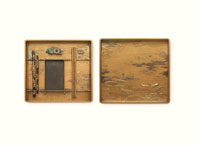 |
A superb example of early Japanese lacquer is brilliantly evidenced in an inkstone box that is one of the outstanding rarities in The Transcendent Spirit: Synthesizes Experience, Embodies Mastery, Transforms Material, Is Beauty, the show that Lesley Kehoe Galleries of Melbourne has assembled for display on the fifth floor of the Fuller Building, 41 East 57th Street. The box is an exemplar of the Igarashi School, which flourished during the Momoyama-Early Edo Period (16th and 17th centuries), and it is richly decorated with autumn grasses. |
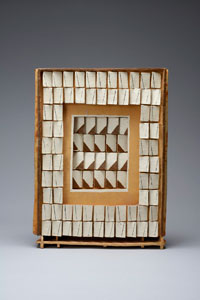 |
In an exhibition called Japan in Black and White: Ink and Clay, New York-based Joan B. Mirviss Ltd, at 39 East 78th Street, is casting a special spotlight on a compelling screen-style sculpture by Yamada Hikaru (1923-2001) titled Tôhen Mandara and created in 1973. This work, made of glazed stoneware and wood, exemplifies the artist’s unending desire to question the perception of flat visual planes. The work also manifests Hikaru’s radical approach in the manipulation of clay. |
 |
Chelsea's Onishi Gallery heads uptown to present Heritage: Contemporary Japanese Ceramics and Other Interior Objects at Hollis Taggart Galleries, 958 Madison Avenue. Called out for particular appreciation is a work by one of the world’s most famous Kutani Potters, Tokuda Yasokichi III (1933–2009), who was designated a Living National Treasure in 1997 for his mastery of the saiyu glaze technique. |
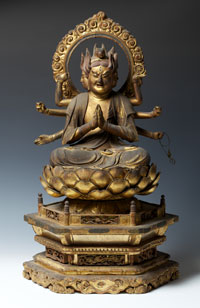 |
At 1016 Madison Avenue, Milan's Giuseppe Piva Japanese Art has pulled together for discerning eyes Yugen: The Subtle Profundity of Japanese Art. Among the highlights is Banō Kannon, one of the warlike and wrathful deities of Esoteric Buddhism. From the early Edo Period (1615-1867), the work is gilt carved wood and has eyes inlaid with crystals. |
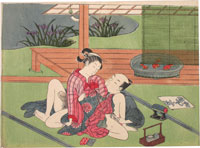 |
New York's Scholten Japanese Art will debut a collection of sensual Japanese prints and paintings—commonly known as shunga (literally, spring pictures)—in Erotic Art of Japan: Everybody's Doing It at 145 West 58th Street, Suite 6D. A highlight of the show is a woodblock print by Suzuki Harunobu (circa 1724-70) showing A Couple Near a Bowl of Goldfish (from an untitled series), circa. 1768. |
 |
In Japanese Paintings and Works of Art at Erik Thomsen, 23 East 67th Street, a dramatic pair of screens from the Taisho period (1912-26) by Suzuki Shonen (1849-1918) is the star attraction in the fourth floor gallery. Shonen was famous for his depictions of pine trees, and he painted this pair of six-panel folding screens, entitled Pine Trees, at the end of his long artistic career, with a striking combination of fine details and bold strokes of ink on gold leaf. The pair measures more than 24 feet in width. |
 |
Hiroshi Yanagi Oriental Art, unveiling Japanese Art Highlights at 1016 Madison Avenue is bringing an especially exquisite object from Japan. Made of cypress and measuring 9 inches tall, it is a standing Amida Nyorai that dates from the 13th century, a time during the Kamakura Period known for a new realism in the artistic portrayals of divinities. |
KOREAN ANCIENT THROUGH CONTEMPORARY
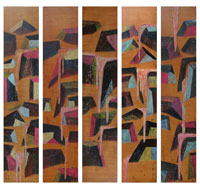 |
Kang Collection Korean Art on the Third Floor at 9 East 82nd Street focuses on the work of Ik-Joong Kang in a show called Bamboo/Wind that displays the artist’s ingenuity in fusing ancient Korean iconography with a modern pop sensibility. This exhibition showcases the latest work of an artist whose impressive résumé includes installations at the Guggenheim, The United Nations and The Museum of Contemporary Art in Los Angeles. |
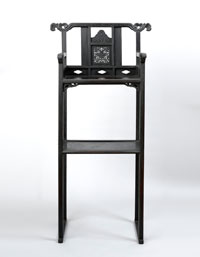 |
KooNewYork’s Korean Traditions: Arts of the Interior presents exceedingly rare Korean antique furniture that is difficult to find in the States at the Mark Murray Gallery on the fifth floor of 39 East 72nd Street. A not-to-be-missed item among the Florida-based gallerist's offerings is an 18th-century Confucian wood altar chair, which is finely reticulated with lotus motifs. |
#######
To celebrate Asia Week New York, a private, by-invitation-only evening reception will take place at the Metropolitan Museum of Art on March 17, 2014. On this special occasion the Met will open all of its Asian Art galleries for viewing and offer guests curator-led tours of the major exhibitions on view in those galleries during Asia Week New York: Ink Art: Past as Present in Contemporary China, the Met’s first Chinese contemporary art exhibition (December 11, 2013–April 7, 2014); The Flowering of Edo Period Painting: Japanese Masterworks from the Feinberg Collection (February 1–September 7, 2014); Tibet and India: New Beginnings (February 8–June 8, 2014); and Small Delights: Chinese Snuff Bottles (July 19, 2013–June 15 2014).
To help visitors easily navigate the Asia Week New York's activities, a comprehensive guide with maps will be available at all participating galleries and auction houses, along with select museums and cultural institutions, beginning February 2014 and online at www.AsiaWeekNY.com. For the second year, to meet the demands of Chinese collectors, an abridged version of the website will be available in Chinese. For more information, visit www.asiaweekny.com.
Asia Week New York Association, Inc. is a 501(c)(6) non-profit trade membership organization registered with the state of New York.
ABOUT ASIA WEEK NEW YORK 2014 SPONSORS
Presenting Sponsor: Amanresorts
Amanresorts was founded by Adrian Zecha, who envisioned a collection of intimate retreats in beautiful surroundings with the unassuming, warm hospitality of a gracious private residence. The first resort, Amanpuri (place of peace) in Phuket, Thailand, introduced the concept. Amanresorts has grown to encompass 26 resorts located in Bhutan, Cambodia, China, France, Greece, Indonesia, India, Italy, Laos, Montenegro, Morocco, the Philippines, Sri Lanka, Thailand, Turkey, the Turks & Caicos Islands, the United States and Vietnam.
Through its partnership with Asia Week New York, Amanresorts spotlights seven of its ne plus ultra resorts from four Asian countries, which include Amanfayun in Hangzhou, China, Aman at Summer Palace in Beijing, China, Amanbagh in Rajasthan, India, Aman-i-Khas in Ranthambore, India, Amangalla in Galle, Sri Lanka, Amanwella in Tangalle, Sri Lanka, and the Amankora in Bhutan. For more information, visit www.amanresorts.com.
Supporting Sponsor: China Center New York
For the second year, Asia Week New York continues its partnership with China Center New York, which is projected to open in early 2015. China Center New York will serve as a gateway for Chinese companies and individuals entering the US to connect with American entities seeking new opportunities with China. Strategically positioned across six floors of the iconic One World Trade Center, China Center New York will be a multifaceted space, comprising a private member club with a restaurant, a tea lounge, a bar, premier event and conference spaces and best-in- class serviced office suites. Members will enjoy fine dining from a world- renowned chef, exclusive events and programming, world-class ambassador services and spectacular views of New York City. For more information, visit www.chinacenter.com.
Editor’s Note: High-resolution jpegs are available upon request.
